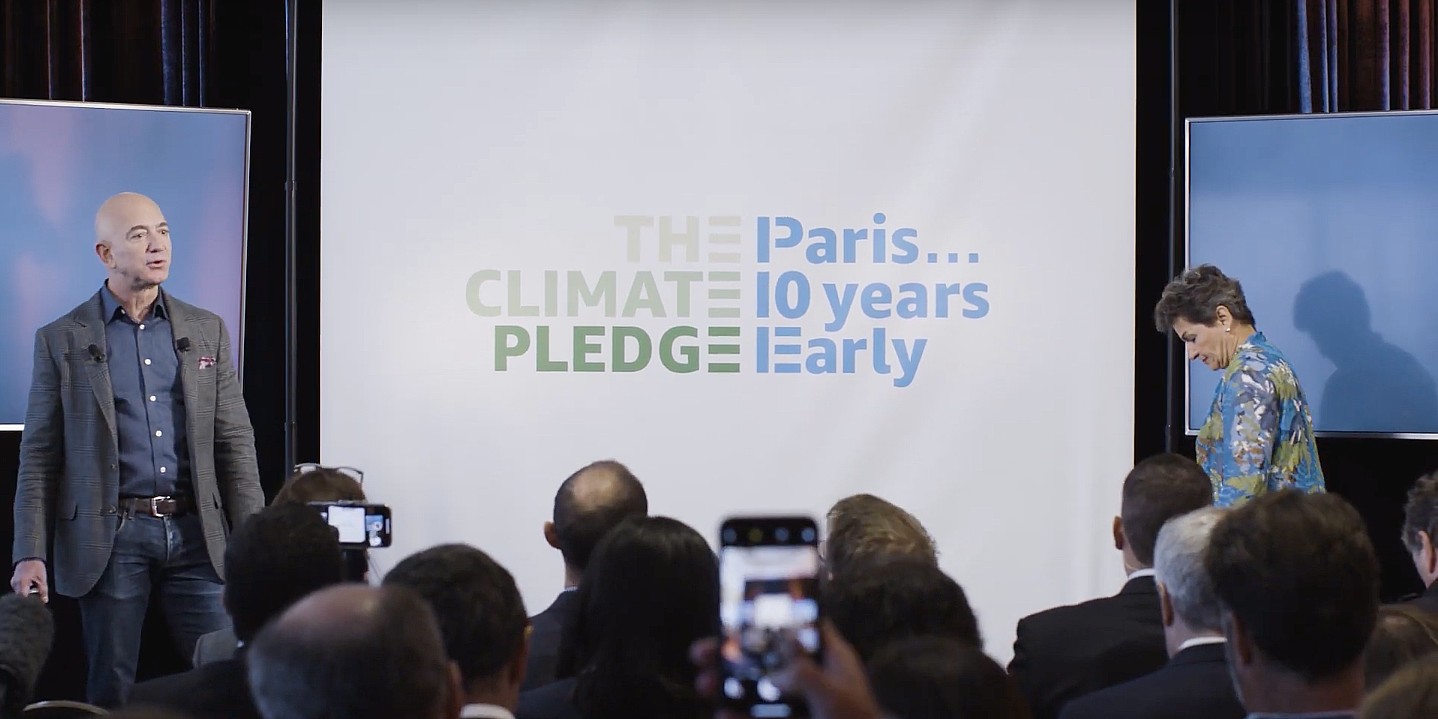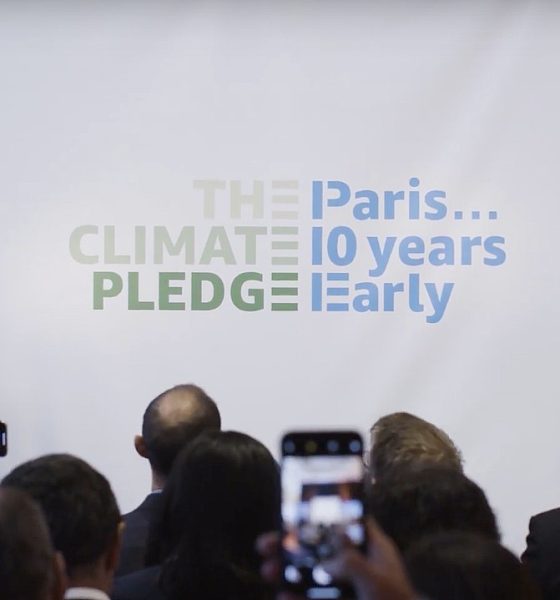

News
Amazon to help boost oil production amid Climate Pledge, Rivian van orders
Just a few weeks ago, Amazon CEO Jeff Bezos announced that his company would be purchasing 100,000 Rivian electric vans to deliver its packages, as well as provide more eco-friendly packaging. The decisions were made after employees demanded he take the necessary steps to reduce the carbon footprint the e-commerce giant was causing. Bezos complied, alleviating the possible strike that Amazon employees were poised to take part in.
It finally seemed like one of the world’s biggest companies was taking an environmental approach to its business model, but that may not entirely be the case. As revealed by a press release from Weatherford, one of the world’s leading oilfield service companies, Amazon was one of the main contributors to the U.S. Oil and Gas Industry’s “Production 4.0” forum at the Enterprise Software Conference in Houston, Texas. The forum’s theme was simple — it centers on the development of technology that can accelerate and improve oil production.
“Weatherford Production 4.0 products, including ForeSite Edge, ForeSite Platform, CygNet Platform and ForeSite Sense, activate field-wide intelligence to maximize production. Weatherford delivers the future of production performance through next-generation automation, IoT infrastructure and advanced optimization software to boost production, uptime and efficiency,” Manoj Nimbalkar, Weatherford’s Global VP of Production Automation and Software, said.
The irony of Amazon’s decision to join this conference is notable. The company, after all, previously committed to delivering its new, environmentally-conscious packages via electric vehicle just a few short weeks ago, and now is helping the oil industry thrive. The future of gas and oil will not only contribute to the global climate crisis, but it also contributes to the decision to not have large corporations take a more environmentally-aggressive approach to the operations of their businesses. The influence Amazon might have carried with its decision to rely less on fossil fuels to power its vehicles could have convinced other companies to follow in its footsteps.
Bezos gained the respect of many eco-friendly groups when he announced his partnership with Rivian. The CEO invested $700M into the electric automaker in February 2019, making the impression that he and his company would begin gearing up for a future that would not include operating on fossil fuels. But when the company began its “Climate Pledge” in mid-September at the National Press Club, details were vague. Bezos was nevertheless adamant about doing his part to help reach the specifics of the Paris Agreement, and even took an aggressive line by stating that he wanted to accomplish the goals 10 years early. Despite the fact that the US will pull out of the agreement on behalf of President Donald Trump later this year, Amazon, at least at the time, have the impression that it was doing its part to contribute to environmental sustainability.
But unfortunately, the old saying “actions speak louder than words” is all too true here. All while Bezos and Amazon were taking the necessary steps to reduce its carbon footprint and become a company that will help the planet, it appears that they were putting an effort to help advance oil and gas companies just the same. It appears they have taken two steps forward and three steps back with this news. After all, when Bezos was asked at the National Press Club meeting in Washington, D.C. if he would sever ties with oil companies that Amazon supports, he gave a firm “No.”
Ten-thousand Rivian vans boasting the Amazon logo are due to hit the road and begin delivering packages in 2021, and the remaining 90,000 will be ready before 2030. It also intends to utilize Earth-friendly packaging materials, apart of the “Shipment Zero” plan, by the end of 2019. But the announcement of Amazon’s participation seems to somewhat derail, or at least delay, any ideas that the company was interested in becoming a sustainable company. After promising employees that it would begin an effort to become “green”, is Amazon really sincere in its efforts to help the climate after all?

Elon Musk
Starlink passes 9 million active customers just weeks after hitting 8 million
The milestone highlights the accelerating growth of Starlink, which has now been adding over 20,000 new users per day.

SpaceX’s Starlink satellite internet service has continued its rapid global expansion, surpassing 9 million active customers just weeks after crossing the 8 million mark.
The milestone highlights the accelerating growth of Starlink, which has now been adding over 20,000 new users per day.
9 million customers
In a post on X, SpaceX stated that Starlink now serves over 9 million active users across 155 countries, territories, and markets. The company reached 8 million customers in early November, meaning it added roughly 1 million subscribers in under seven weeks, or about 21,275 new users on average per day.
“Starlink is connecting more than 9M active customers with high-speed internet across 155 countries, territories, and many other markets,” Starlink wrote in a post on its official X account. SpaceX President Gwynne Shotwell also celebrated the milestone on X. “A huge thank you to all of our customers and congrats to the Starlink team for such an incredible product,” she wrote.
That growth rate reflects both rising demand for broadband in underserved regions and Starlink’s expanding satellite constellation, which now includes more than 9,000 low-Earth-orbit satellites designed to deliver high-speed, low-latency internet worldwide.
Starlink’s momentum
Starlink’s momentum has been building up. SpaceX reported 4.6 million Starlink customers in December 2024, followed by 7 million by August 2025, and 8 million customers in November. Independent data also suggests Starlink usage is rising sharply, with Cloudflare reporting that global web traffic from Starlink users more than doubled in 2025, as noted in an Insider report.
Starlink’s momentum is increasingly tied to SpaceX’s broader financial outlook. Elon Musk has said the satellite network is “by far” the company’s largest revenue driver, and reports suggest SpaceX may be positioning itself for an initial public offering as soon as next year, with valuations estimated as high as $1.5 trillion. Musk has also suggested in the past that Starlink could have its own IPO in the future.
News
NVIDIA Director of Robotics: Tesla FSD v14 is the first AI to pass the “Physical Turing Test”
After testing FSD v14, Fan stated that his experience with FSD felt magical at first, but it soon started to feel like a routine.

NVIDIA Director of Robotics Jim Fan has praised Tesla’s Full Self-Driving (Supervised) v14 as the first AI to pass what he described as a “Physical Turing Test.”
After testing FSD v14, Fan stated that his experience with FSD felt magical at first, but it soon started to feel like a routine. And just like smartphones today, removing it now would “actively hurt.”
Jim Fan’s hands-on FSD v14 impressions
Fan, a leading researcher in embodied AI who is currently solving Physical AI at NVIDIA and spearheading the company’s Project GR00T initiative, noted that he actually was late to the Tesla game. He was, however, one of the first to try out FSD v14.
“I was very late to own a Tesla but among the earliest to try out FSD v14. It’s perhaps the first time I experience an AI that passes the Physical Turing Test: after a long day at work, you press a button, lay back, and couldn’t tell if a neural net or a human drove you home,” Fan wrote in a post on X.
Fan added: “Despite knowing exactly how robot learning works, I still find it magical watching the steering wheel turn by itself. First it feels surreal, next it becomes routine. Then, like the smartphone, taking it away actively hurts. This is how humanity gets rewired and glued to god-like technologies.”
The Physical Turing Test
The original Turing Test was conceived by Alan Turing in 1950, and it was aimed at determining if a machine could exhibit behavior that is equivalent to or indistinguishable from a human. By focusing on text-based conversations, the original Turing Test set a high bar for natural language processing and machine learning.
This test has been passed by today’s large language models. However, the capability to converse in a humanlike manner is a completely different challenge from performing real-world problem-solving or physical interactions. Thus, Fan introduced the Physical Turing Test, which challenges AI systems to demonstrate intelligence through physical actions.
Based on Fan’s comments, Tesla has demonstrated these intelligent physical actions with FSD v14. Elon Musk agreed with the NVIDIA executive, stating in a post on X that with FSD v14, “you can sense the sentience maturing.” Musk also praised Tesla AI, calling it the best “real-world AI” today.
News
Tesla AI team burns the Christmas midnight oil by releasing FSD v14.2.2.1
The update was released just a day after FSD v14.2.2 started rolling out to customers.

Tesla is burning the midnight oil this Christmas, with the Tesla AI team quietly rolling out Full Self-Driving (Supervised) v14.2.2.1 just a day after FSD v14.2.2 started rolling out to customers.
Tesla owner shares insights on FSD v14.2.2.1
Longtime Tesla owner and FSD tester @BLKMDL3 shared some insights following several drives with FSD v14.2.2.1 in rainy Los Angeles conditions with standing water and faded lane lines. He reported zero steering hesitation or stutter, confident lane changes, and maneuvers executed with precision that evoked the performance of Tesla’s driverless Robotaxis in Austin.
Parking performance impressed, with most spots nailed perfectly, including tight, sharp turns, in single attempts without shaky steering. One minor offset happened only due to another vehicle that was parked over the line, which FSD accommodated by a few extra inches. In rain that typically erases road markings, FSD visualized lanes and turn lines better than humans, positioning itself flawlessly when entering new streets as well.
“Took it up a dark, wet, and twisty canyon road up and down the hill tonight and it went very well as to be expected. Stayed centered in the lane, kept speed well and gives a confidence inspiring steering feel where it handles these curvy roads better than the majority of human drivers,” the Tesla owner wrote in a post on X.
Tesla’s FSD v14.2.2 update
Just a day before FSD v14.2.2.1’s release, Tesla rolled out FSD v14.2.2, which was focused on smoother real-world performance, better obstacle awareness, and precise end-of-trip routing. According to the update’s release notes, FSD v14.2.2 upgrades the vision encoder neural network with higher resolution features, enhancing detection of emergency vehicles, road obstacles, and human gestures.
New Arrival Options also allowed users to select preferred drop-off styles, such as Parking Lot, Street, Driveway, Parking Garage, or Curbside, with the navigation pin automatically adjusting to the ideal spot. Other refinements include pulling over for emergency vehicles, real-time vision-based detours for blocked roads, improved gate and debris handling, and Speed Profiles for customized driving styles.








